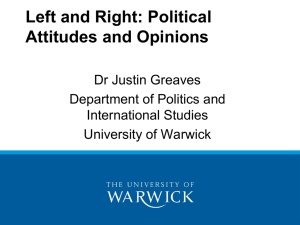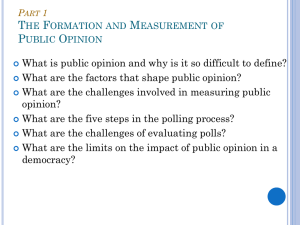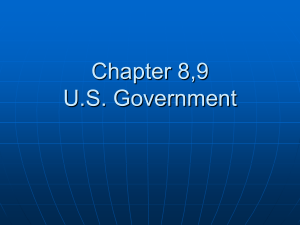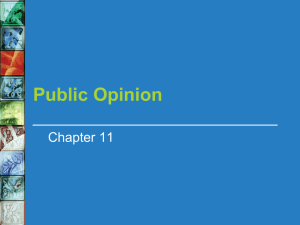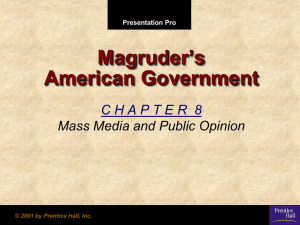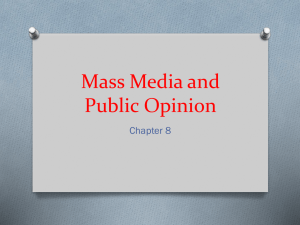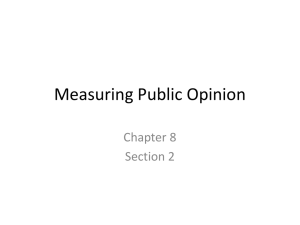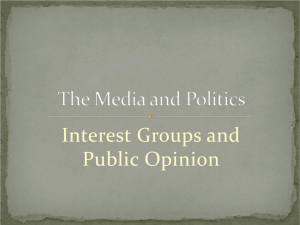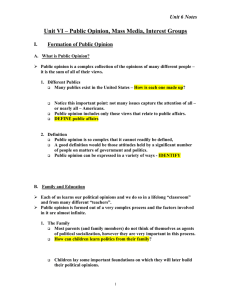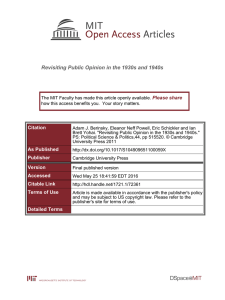Unit 2 - Mass Media & Public Opinion
advertisement
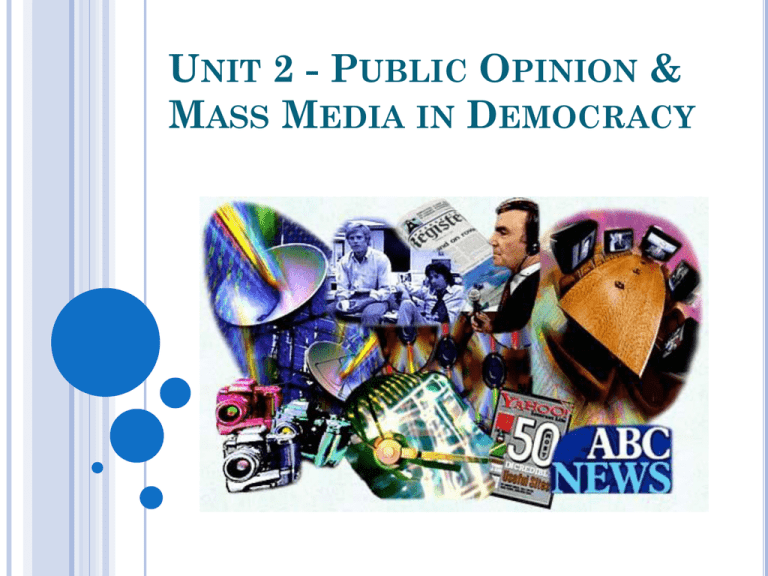
UNIT 2 - PUBLIC OPINION & MASS MEDIA IN DEMOCRACY ESSENTIAL QUESTION Why is critical examination of information an essential responsibility of citizens in a democratic society? PART 1 THE FORMATION AND PUBLIC OPINION MEASUREMENT OF What is public opinion and why is it so difficult to define? What are the factors that shape public opinion? What are the challenges involved in measuring public opinion? What are the five steps in the polling process? What are the challenges of evaluating polls? What are the limits on the impact of public opinion in a democracy? WHAT IS PUBLIC OPINION? Def: Attitudes held by people on matters of government and politics. Different Publics The US has many groups, or publics, who share common views. Public Opinions More than one public opinion can exist at the same time. A view or position must be expressed in the open in order to a public opinion. FACTORS INFLUENCING PUBLIC OPINION Mass Media Def. - means of communication that reach large, widely dispersed audiences simultaneously. Peer Groups The people with whom one regularly associates. (friends, classmates, neighbors) Opinion Leaders Anyone who has an unusually strong influence on others’ views. Historic Events Ex) 9/11 helped shape the political views and opinions of all Americans. The Schools Children acquire political knowledge as they are taught about political systems, patriotism, and great Americans. The Family Children first see the political world from within the family and spent large amounts of time with them. MEASURING PUBLIC OPINION Elections Interest Groups • Private organizations whose members share certain views and work to shape public policy. The Media • The media are both “mirrors” and “molders” of opinion. Personal Contacts • Public officials rely on contacts with their constituents, such as reading their mail, answering calls, and meeting people in public. POLLS—THE BEST MEASURE Public opinion is best measured by public opinion polls, devices that attempt to collect information by asking people questions. THE POLLING PROCESS Defining the Universe • The universe means the population that the poll aims to measure. Constructing a Sample • A sample is a representative slice of the poll’s population. Preparing Valid Questions • The way in which questions are worded is very important. Wording can affect the reliability of any poll. Interviewing • Pollsters communicate with the sample respondents using various methods including person-to-person interviews, telephone calls, and mail surveys. Reporting • Pollsters use computers to store and manipulate data, which helps them analyze and report the results of the poll. EVALUATING POLLS AND THEIR LIMIT ON PUBLIC OPINION Evaluating Polls Most national and regional polls are fairly reliable, but far from perfect. Problems Cannot measure intensity, stability, and relevance of the opinions they report. Polls sometimes shape the opinions they are supposed to measure. Limits on the Impact of Public Opinion Public opinion is the major, but by no means the only, influence on public policy. The Government protects minority interests against the excesses of majority views and actions. Finally, polls are not elections, nor are they substitutes for elections. PART 2 THE MASS MEDIA How does the mass media fulfill its role to provide the public with political information? How does the mass media influence politics? What are the factors that limit the influence of the media? THE ROLE OF MASS MEDIA Mass media is a medium of communication for the public. Television Newspapers Politics and television have gone hand in hand since the technology first appeared. Today television is the principle source of political information for a majority of Americans. The first newspapers carried mostly political news. Even with the total number of newspapers declining, they are still the second leading source of political information for most Americans. Radio Magazines On average, Americans hear 20 hours of radio each week. Radio has been a source of news and entertainment since 1920. Some 12,000 magazines are published in the United States today. Several magazines are devoted to American news and politics. Internet The internet provides instant and continual access to all previously mentioned mediums, as well as web-only content such as blogs and political commentary sites. THE MEDIA AND POLITICS The Public Agenda The media play a large role in shaping the public agenda, the societal problems that political leaders and citizens agree need government attention. The media does not tell the people what to think; but it is clear that they tell the people what to think about. Electoral Politics Today, television allows candidates to appeal directly to the people, without the help of a party organization. Candidates regularly try to use media coverage to their advantage. Newscasts featuring candidates are usually short, sharply focused sound bites—snappy reports that can be aired in 30 to 45 seconds. LIMITS ON MEDIA INFLUENCE Only a small part of the public actually takes in and understands much of what the media have to say about public affairs. Many media sources mostly skim the news, reporting only what their editors judge to be the most important and/or most interesting stories of the day. In-depth coverage of public affairs is available to those who want it and will seek it out. PART 3 PROPAGANDA & LANGUAGE OF POLITICAL ADVERTISEMENTS REPETITION •One way to drive a message home is repetition. •In all forms of advertising that use jingles or slogans, repetition is intended to keep a word or phrase in the minds of the viewers. •The more times viewers hear a name, word, or phrase, the more likely they are to remember it. SYNTAX : SHORT & INCOMPLETE, OR LONG & LYRICAL The syntax, or grammatical structure of words, used in ads achieves different purposes when used in different ways. Some ads, favor complex, lengthy, complete sentences. This method requires more thought and attention on the part of the viewer, but often presents a more complete picture of the candidate. •Others utilize fragments or phrases, which are easily accessible to the viewer, but may not fully explain the candidate’s position. “LOADED LANGUAGE”: POSITIVE AND NEGATIVE WORDS The use of “loaded” language— words with strong positive or negative emotional associations—is a long-standing tradition in political advertising. The use of positive and negative words is a common technique of partisan attacks. It is an important strategy used by candidates and advisers of both parties to sway voter opinion.
